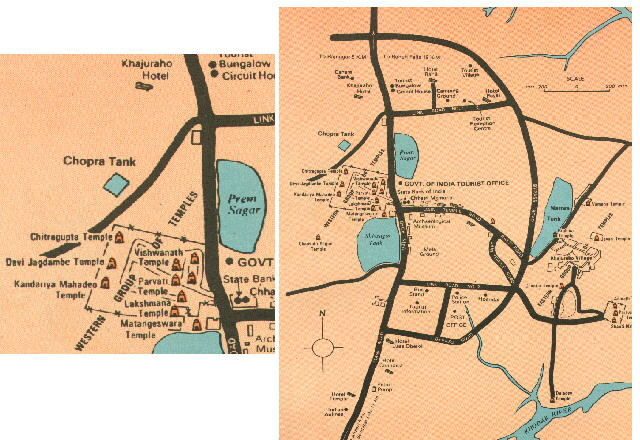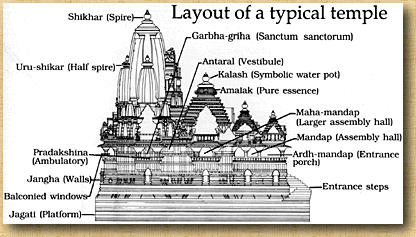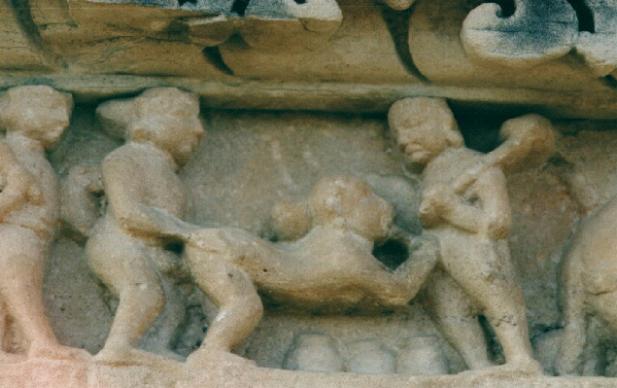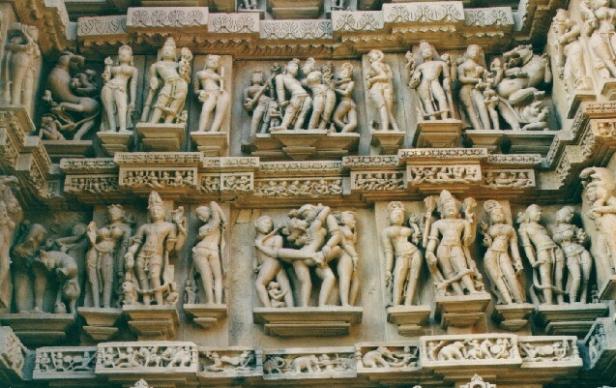The
Tantric Temples of Khajuraho
in
the state of Madhya Pradesh, North India
The
city of Khajuraho is the legacy of the Chandela Dynasty.
King
Yasovarman began the era of temple construction early
in
the tenth century CE. Eighty-five temples were built, of
which
only twenty two still exist. The murals and friezes
depict
scenes from hunting, warfare, feasting, dancing, and
so
forth, but are best known for their many erotic depictions, all
of
which -- like the famous ancient erotic Hindu scripture, the
Kama
Sutra ("Love Lesson") -- are spiritual in nature. In fact,
the
temples of Khajuraho have often been called the Kama Sutra
temples,
whether or not they were consciously modeled after that
book.
They certainly are in the same tradition.
The
existing temples, all of which were built between 900 and
1050
CE, are laid out in three regions: west, east, and south.

The
western group (highlighted above and pictured below)
is
by far the most spectacular. Though the map indicates ten,
there
are other smaller standing temples, and the ruins of
others.
Most lie in a rather jagged row that runs from north to
south
on the east side of this western site, the two most
impressive
being the Vishvanatha and Lakshmana. Far more
impressive,
however, are the three that form another row
on
the west side of this site: Chitragupta, Devi Jagdambe,
and
(above all) Kandariya Mahadeva.
All
of the large temples at Khajuraho are variations of the
Nagara
style of North India, which looks like this:

(
Because these famous temples are in the Tantric
Hindu
tradition,
some of the sculptures on them are
erotic in
nature, and are not suitable for viewing by
children or
anyone sensitive about graphic sexual imagery.
In order to
avoid being offended, do not scroll down past the
first eighteen
images.)
Clicking on any image will give a larger version of it.
The
following
three images are of temples in the
northeast
quadrant of the western group site, the
largest of
which is the Vishvanatha.
The Vishvanatha is dedicated to Lord Shiva.
Though
quite
spectacular in its own right,
the
Vishvanatha
is only a smaller copy of the
largest and
most impressive of the temples of the
western group
at Khajuraho, the Kandariya Mahadevo
Temple
(pictured immediately below), which is the
southernmost
of the three temples
on the west
side of this western group site.
The shikhara
(spire) of the Kandariya Mahadevo
rises to
nearly
100 feet. The friezes around it and
the rest of
the temple are some of the best preserved
at Khajuraho,
and contain some of the most famous
of the erotic
depictions (see below).
Just
to the north of Kandariya Mahadevo Temple
(and on the
right in the following photo) is the
Devi Jagdambe
Temple, which was first dedicated to
the god
Vishnu,
but later rededicated to Kali.
Of
similar
style to the Kandariya, but simpler, the Devi
Jagdambe is
really a smaller replica of the temple just
to the north
of it, the Chitragupta Temple (next photo),
which was
built in 1000 CE and dedicated to Surya,
the sun god.
The
following
two images are of the Lakshmana Temple,
dedicated
to the god Vishnu in 954 CE, making it the oldest
of the
standing
temples here. Though smaller in size than
the Kandariya
Mahadevo, the Lakshmana is similar in style
and in many
ways the best preserved temple at Khajuraho.
Here is one
of the many images of the ever-present
Ganesha (or
Ganesh), the elephant-headed son of
the god Shiva,
and -- as "The Remover of Obstacles" --
the god of
good fortune. No matter to which deity a
temple in
India is dedicated, there is often a shrine to
Ganesha at
the entrance, where prayers are offered
to him to
ensure that prayers to other deities will
be effectual.
The images beyond this point are very graphic
depictions
of a sexual nature.
The purpose
of incorporating such images as the
following
in Hindu architecture and art was not simply
decorative,
much less titillating in a pornographic sort of way,
but was in
fact spiritual. In Tantric Hinduism (as in Tantric
Buddhism),
the male and female represent two important
aspects of
both the human spirit (atman) and the Ultimate
Spirit (Brahman),
all of which constitute (according to the
Upanishads)
a cosmic Unity. As with the yin and yang of
ancient
Chinese
philosophy, male and female are not polar
opposites,
but two complementary aspects in an eternal,
dynamic, and
multifaceted process of spiritual and
physical
unfoldment.
Sexual imagery and indeed sexual
practice (as
evidenced by the famous Hindu scripture,
Kama Sutra or
"Love Lesson") are not only appropriate
but fitting
spiritual expressions, which offer a foretaste of
the ultimate
experience of liberation (moksha or nirvana)
and bliss
(ananda) to which both philosophy and religion
in the East
ideally point and lead.
The first
two
images show a little kissing and moderate
groping.
Things quickly become more heated, however.
Ever-present
are images and symbols of Shiva, the god
of sexuality
and, oddly enough, of ascetics who renounce
sex.
(Shiva is also a god of destruction, decay, and death,
as well as
creation, dance, music, and spiritual liberation.)
The
following
image is perhaps the most famous of all
of the
thousands
at Khajuraho. The geometric pattern
formed by
the limbs of the participants actually represents
a yantra,
a design representing the inner spiritual dynamic
of the cosmos.
Those who
have studied these temples and their sculptures
most
diligently
have identified over eighty sexual positions
depicted.
The variety is imaginative to say the least, and
many of the
scenes exhibit a tongue-in-cheek (so to speak)
sense of humor.


The final
image below is a case in point. The elephant
on the right,
which is part of a formation, breaks ranks by
turning his
head to his left to behold a curiously
coupled human
couple and laughing at the sight.
Namaste!
![]()

